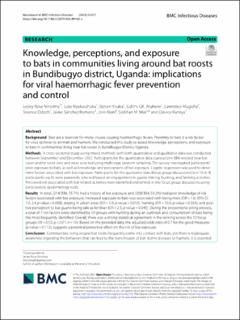| dc.contributor.author | Ninsiima, Lesley Rose | |
| dc.contributor.author | Nyakarahuka, Luke | |
| dc.contributor.author | Kisaka, Steven | |
| dc.contributor.author | Atuheire, Collins GK. | |
| dc.contributor.author | Mugisha, Lawrence | |
| dc.contributor.author | Odoch, Terence | |
| dc.contributor.author | Romano, Javier Sánchez | |
| dc.contributor.author | Klein, Jörn | |
| dc.contributor.author | Mor, Siobhan M. | |
| dc.contributor.author | Kankya, Clovice | |
| dc.date.accessioned | 2024-03-20T09:32:27Z | |
| dc.date.available | 2024-03-20T09:32:27Z | |
| dc.date.created | 2024-03-19T14:41:54Z | |
| dc.date.issued | 2024 | |
| dc.identifier.citation | Ninsiima, L. R., Nyakarahuka, L., Kisaka, S., Atuheire, C. G. K., Mugisha, L., Odoch, T., Romano, J. S., Klein, J., Mor, S. M., & Kankya, C. (2024). Knowledge, perceptions, and exposure to bats in communities living around bat roosts in Bundibugyo district, Uganda: implications for viral haemorrhagic fever prevention and control. BMC Infectious Diseases, 24, Artikkel 311. | en_US |
| dc.identifier.issn | 1471-2334 | |
| dc.identifier.uri | https://hdl.handle.net/11250/3123303 | |
| dc.description.abstract | Background: Bats are a reservoir for many viruses causing haemorrhagic fevers. Proximity to bats is a risk factor for virus spillover to animals and humans. We conducted this study to assess knowledge, perceptions, and exposure to bats in communities living near bat roosts in Bundibugyo District, Uganda.
Methods: A cross-sectional study using mixed methods with both quantitative and qualitative data was conducted between September and December 2022. Participants for the quantitative data (survey) (n = 384) resided near bat caves and/or roost sites and were selected using multistage random sampling. The survey investigated participants’ prior exposure to bats, as well as knowledge and perceptions of bat exposure. Logistic regression was used to determine factors associated with bat exposure. Participants for the qualitative data (focus group discussions) (n = 10, 6–8 participants each) were purposely selected based on engagement in guano mining, hunting, and farming activities. Perceived risk associated with bat-related activities were identified and ranked in the focus group discussions using participatory epidemiology tools.
Results: In total, (214/384, 55.7%) had a history of bat exposure and (208/384, 54.2%) had poor knowledge of risk factors associated with bat exposure. Increased exposure to bats was associated with being male (OR = 1.6; 95% CI: 1.0, 2.4 p-value = 0.038), staying in urban areas (OR = 1.9; p-value = 0.010), hunting (OR = 10.9; p-value = 0.024), and positive perception to bat guano being safe as fertiliser (OR = 2.5; p-value = 0.045). During the proportional piling process, a total of 7 risk factors were identified by 10 groups with hunting during an outbreak and consumption of bats being the most frequently identified. Overall, there was a strong statistical agreement in the ranking across the 10 focus groups (W = 0.52; p < 0.01; n = 10). Based on the provided data, the adjusted odds ratio of 0.7 for the good measures (p-value = 0.112), suggests a potential protective effect on the risk of bat exposure.
Conclusion: Communities living around bat roosts frequently come into contact with bats, yet there is inadequate awareness regarding the behaviors that can lead to the transmission of bat- borne diseases to humans. It is essential to undertake educational initiatives and preventive measures to minimise the risks of bat-related infections. The need for targeted health communication and education efforts to address these knowledge gaps and promote an accurate understanding of bats and disease transmission. Understanding of diseases associated with bats will minimize bat-related health risks especially in communities engaged in wildlife hunting. | en_US |
| dc.language.iso | eng | en_US |
| dc.rights | Navngivelse 4.0 Internasjonal | * |
| dc.rights.uri | http://creativecommons.org/licenses/by/4.0/deed.no | * |
| dc.title | Knowledge, perceptions, and exposure to bats in communities living around bat roosts in Bundibugyo district, Uganda: implications for viral haemorrhagic fever prevention and control | en_US |
| dc.type | Peer reviewed | en_US |
| dc.type | Journal article | en_US |
| dc.description.version | publishedVersion | en_US |
| dc.rights.holder | © The Author(s) 2024. | en_US |
| dc.source.volume | 24 | en_US |
| dc.source.journal | BMC Infectious Diseases | en_US |
| dc.identifier.doi | https://doi.org/10.1186/s12879-024-09162-x | |
| dc.identifier.cristin | 2255801 | |
| dc.source.articlenumber | 311 | en_US |
| cristin.ispublished | true | |
| cristin.fulltext | original | |
| cristin.qualitycode | 1 | |

